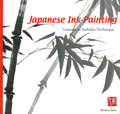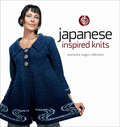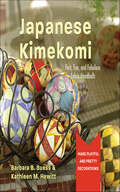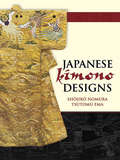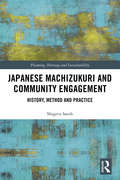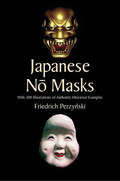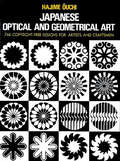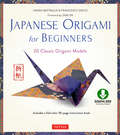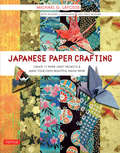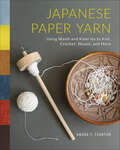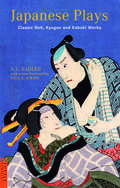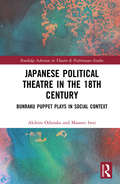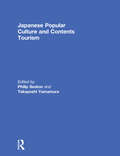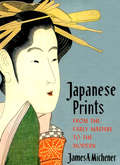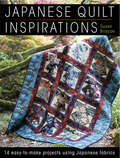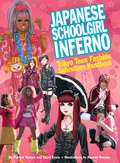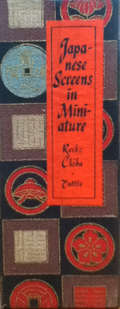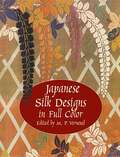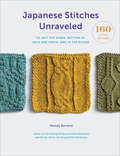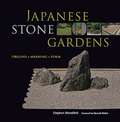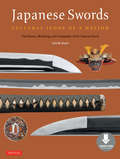- Table View
- List View
Japanese Ink Painting
by Ryukyu SaitoHere is a book to teach the beginner the fundamental techniques of suiboku, the unique form of Oriental art that has produced some of the world's finest masterpieces of ink-painting. Originating in China and having its spiritual basis in Zen Buddhism, this form of expressing nature's colors through shades of black ink monochrome has been enjoyed throughout the centuries in the Orient as a hobby for the amateur.
Japanese Ink Painting
by Ryukyu SaitoHere is a book to teach the beginner the fundamental techniques of suiboku, the unique form of Oriental art that has produced some of the world's finest masterpieces of ink-painting. Originating in China and having its spiritual basis in Zen Buddhism, this form of expressing nature's colors through shades of black ink monochrome has been enjoyed throughout the centuries in the Orient as a hobby for the amateur.
Japanese Inspired Knits: Marianne Isager Collection
by Marianne IsagerInspired by the seasonal festivals and traditions of Japan, this blend of traditional Scandinavian knitting with distinctive Japanese influences explores the beautiful design elements steeped in folk customs. Created especially for women, these patterns are true to the Japanese ideals of high-quality design and materials. Twelve sweaters, oriented around the months of the year, are each knitted using nearly a dozen different techniques. With project names like "Sake and Soba," "Summer in Tokyo," "Rice Fields," "Flower Buds," and "Stone Garden," knitters will have plenty of inspiration. In addition to standard knit and purl combinations, the patterns feature double knitting, domino knitting, shadow knitting, lace, cables, entrelac, intarsia, and stranded two-color knitting. All techniques are described in detail with clear text and illustrations, and an illustrated glossary at the end of the book provides technical instruction needed for any project. Also included are Japanese ideographs that relate to themes that inspired the projects, a Japanese calendar, plus lush travel photography of Japan that will inspire any knitter.
Japanese Kimekomi: Fast, Fun, and Fabulous Fabric Handballs
by Barbara B. Suess Kathleen M. HewittThe fun and easy Japanese craft of Kimekomi (pronounced kee-may-ko-mee)—the making of decorative fabric balls—dates back to the early 1700s with the making of cloth-covered wooden dolls. Today it has evolved into the artful covering of balls with cloth and ribbon and cord. In Japanese Kimekomi: Fast, Fun, and Fabulous Fabric Handballs authors Barbara Suess and Kathleen Hewitt have collected 16 colorful designs that are fun and easy to make. The book includes step-by-step drawings and color photos, full-size cutting templates, and easy-to-follow directions. The art requires no sewing skills, just some fabric, styrofoam balls, and a couple of hours. Begin with making simple but beautiful handballs and progress with the authors to creating new, unique designs. Nothing could be more charming as a gift, Christmas or Easter ornament, or party tokens.
Japanese Kimono Designs
by Shôjirô Nomura Tsutomu EmaJapan's ancient and esteemed tradition of textile arts has long been reflected in the delicate beauty of the kimono and its appealing designs. This unique design treasury, consisting of lavish full-color pictures of a vibrant array of kimonos, is reproduced directly from two rare and costly original portfolios.Devotees of fashion, art, and Asian culture will appreciate this beautiful book and its tribute to the elegance and refinement of Japanese art, as expressed in the colorful grace of kimono designs.
Japanese Love Hotels: A Cultural History (Routledge Contemporary Japan Series #Vol. 15)
by Sarah ChaplinDrawing on theories of place, consumption and identity, Sarah Chaplin details the evolution of the love hotel in urban Japan since the 1950s. Love hotels emerged in the late 1950s following a ban of licensed prostitution, then were extremely popular in the 1970s, were then legislated against in the 1980s and are now perceived as ‘leisure’, ‘fashion’ or ‘boutique’ hotels. Representing a timely opportunity to capture and evaluate the dying manifestations of an important era in Japanese social and cultural history, this book provides a critical account of the love hotel as a unique typology. It considers its spatial, aesthetic, semiotic, and locational denotations and connotations, which results in a richly nuanced cultural reading. The love hotel is presented as a key indicator of social and cultural change in post-war Japan, and as such this book will be of interest to a wide and international readership including students of Japanese culture, society and architecture.
Japanese Machizukuri and Community Engagement: History, Method and Practice (Planning, Heritage and Sustainability)
by Shigeru SatohOver the past few decades, Japan has faced severe earthquake disasters, an increasing aging population, declining birth rates, and widening social disparities. These issues have served to highlight gaps left by top-down governance approaches and the urgent need to create resilient societies using more traditional models. Japanese “machizukuri” has developed to become an exceptional example of bottom-up creative approaches based on collective action and use of local resources. Since its evolution in the 1960s, machizukuri has come to define diverse and creative community-driven management models, by which local communities are enabled to actively tackle problem-solving. Including contributions from experts directly engaged in the process, this book explores the original development of machizukuri in Japan, its diffusion through East Asia and the positive outcomes of this transfer. Combining theoretical explanations with practical case studies, from pre-disaster planning in Tokyo, to the revitalization of historic towns and rural areas around Japan, the book looks at specific solutions, tools, and links between academics, communities, organizations, governmental bodies, and the private sector. It will appeal to researchers in planning, community engagement, architecture, urban design, and sustainable development.
Japanese No Masks: With 300 Illustrations of Authentic Historical Examples
by Stanley Appelbaum Friedrich PerzynskiCombining elements of dance, drama, music and poetry, the performances of Japanese No theater are a highly stylized form of entertainment. Accompanying the sumptuous costumes worn during performances are elaborately carved No and Kyogen wooden masks--major works of art in their own right. This book, based on a classic two-volume German study, presents a wealth of illustrations and information relating to these magnificent theatrical devices.A new, informative introduction and extensive captions derived from the original text and newly translated, accompany the heart of the book--more than 120 full-page plates depicting museum-quality masks worn by actors playing gods, warriors, demons, and monsters, beautiful women, feudal lords, mad characters, and supernatural beings. All 303 illustrations from the original two-volume work are included.A unique introduction to classic Japanese theater for Western theatergoers, this volume will also serve as an excellent reference for students, scholars, and enthusiasts of No drama.
Japanese Optical and Geometrical Art (Dover Pictorial Archive)
by Hajime OuchiSome of the most ingenious and attractive modern motifs. 746 designs.
Japanese Origami for Beginners Kit
by Vanda Battaglia Francesco DecioMake simple and fun paper craft models with this easy origami book and paper kit. The ancient art of origami originated in Japan, where it is steeped in traditional values. The 20 models presented in this kit include many with strong symbolic meanings, such as the carp, the frog and the crane, which symbolize longevity, good luck and perseverance. Also included in this kit are paper models which have practical uses, such as a bag in which to store spices or powdered medications, the masu box for containing small gifts, and uniquely shaped notes with elaborate closures. The more playful side of origami is represented as well: the stylized sumo wrestler with realistic moves has entertained Japanese children for centuries, and the paper Samurai hat is fun to play with. Origami is an ideal activity for children since paper folding develops dexterity and creativity. Origami is also a craft based on a few fundamental 3D folding techniques, soJapanese Origami for Beginners Kit is a useful starting point for fans of all ages and abilities. Although this book is aimed at origami beginners, it contains projects suitable for origami fans of all ages and abilities and is the perfect book for all those who enjoy making things with their hands. This book opens with an illustrated history of origami that highlights the masters and evolution of this pastime and art form up until the present day. A glossary of important origami folding symbols shows you how to follow the diagrams, which are commonly used to indicate how to fold origami models. Easy-to-follow step-by-step instructions follow for each of the 20 models. For those who prefer to see the models folded, this kit includes complete video instructions on a free DVD. It also has72 high-quality origami folding papers, all decorated with a wide selection of traditional Japanese designs and patterns. All of the folds are simple enough to be origami-for-kids projects and are a great way to learn origami. None of the projects require paint or glue; so just grab the included origami paper and start folding right away!
Japanese Paper Crafting
by Richard L. Alexander Michael G. Lafosse Greg MudarriAcross the country interest in paper crafts is booming. People from all walks of life are creating scrapbooks, making gift cards and learning origami. Washi, a traditional handmade paper originating in Japan, is a perfect accompaniment to these crafts. Japanese Paper Crafting teaches the essentials of making beautiful and unusual washi paper at home.Using diagrams and photographs, this book's step-by-step instructions will show both novice and experienced paper artists how to make washi paper and how to create 17 exciting washi projects with their own handmade paper! Projects include a hand-bound blank book; purses and wallets; desktop and tabletop accessories.
Japanese Paper Toys: Origami Paper Toys that Walk, Jump, Spin, Tumble and Amaze! (Downloadable Material Included)
by Andrew Dewar Kostya VintsMake moveable origami projects with this great beginner level origami ebook! Origami Paper Toys is a unique paper craft ebook that brings together the of art paper folding and the fun of moveable toys. Amaze your friends as you watch your origami paper creations wiggle, walk, tumble, shuffle and spin right before your eyes! Renowned origami artist and teacher, Andrew Dewar has designed these origami for kids projects to be simple enough to be completed quickly and easily. No need to learn origami folding, painting or cutting-just punch fold and enjoy!This easy origami ebook contains: A full-colored 64-page booklet Clear step-by-step instruction and easy-to-follow diagrams 24 fun-to-do projects Downloadable papers 2 different paper sizes and many colorsOrigami Paper Toys is a great value and is packed with hours of entertainment suited for all ages. The step-by-step diagrams clearly show how an origami model is assembled as well as how it will move. Basic explanations of tools and techniques mean that the creative folder will soon be folding their own original karakuri origami creations!Origami projects include: Sumo Wrestlers Bobbing Bird Jumping Frog Lola the Ladybug And many more...
Japanese Paper Yarn: Using Washi and Kami-ito to Knit, Crochet, Weave, and More
by Andra F. StantonTeaches crafters how to make and use a gorgeous material for extra enjoyment in knitting, crocheting, and weaving: paper yarn. “Ancient techniques for a contemporary application. A must have for every artist who works with paper. Informative and very inspirational!” --Anna van Bohemen, fiber artist Explore Japanese paper yarn to add new dimensions to your favorite fiber crafts like knitting, crocheting, macrame, weaving, or mixed media. Textile artist Andra F. Stanton focuses you on a fresh perspective: crafting with paper yarn instead of expected yarns of wool or cotton. • Beginning with its deep roots in Japan, learn about paper yarn's rich versatility. • With simple instructions, make your own paper yarn from a sheet of kozo paper. • Try 12 inspiring projects, from beginner-friendly pulped paper weaving to a more-experienced-level knitted scarf. Then you're ready to use paper yarn to take your own favorite crafts in new directions. Throughout, enjoy photos of works by dozens of the contemporary artists who have brought paper yarn to the West's galleries and museums of the 21st century. Whatever your crafting level, this is an accessible resource, blending history, instructions, and artistic inspiration. Elevate your making with the tranquility of a traditional process that is perfect for mindful crafting.
Japanese Plays
by A. L. Sadler Paul S. AtkinsNothing reflects the beauty of life as much as Japanese theater. It is here that reality is held suspended and emptiness can fill the mind through words, music, dance, and mysticism. A.L. Sadler translates the mysteries of Noh, Kyogen, and Kabuki in his groundbreaking book, Japanese Plays. A seminal classic, it provides a cross section of Japanese theater that gives the reader a sampler of its beauty and power.
Japanese Political Theatre in the 18th Century: Bunraku Puppet Plays in Social Context (Routledge Advances in Theatre & Performance Studies)
by Akihiro Odanaka Masami IwaiBunraku has fascinated theatre practitioners through its particular forms of staging, such as highly elaborated manipulation of puppets and exquisite coordination of chanters and shamisen players. However, Bunraku lacks scholarship dedicated to translating not only the language but also cultural barriers of this work. In this book, Odanaka and Iwai tackle the wealth of bunraku plays underrepresented in English through rexamining their siginifcance on a global scale. Little is written on the fact that bunraku theatre, despites its elegant figures of puppets and exotic stories, was often made as a place to manifest the political concerns of playwrights in the 18th century, hence a reflection of the audience's expectation that could not have materialized outside the theatre. Japanese Political Theatre in the 18th Century aims to make bunraku texts readable for those who are interested in the political and cultural implications of this revered theatre tradition.
Japanese Popular Culture and Contents Tourism
by Philip Seaton and Takayoshi YamamuraContents tourism is tourism induced by the contents (narratives, characters, locations and other creative elements) of films, novels, games, manga, anime, television dramas and other forms of popular culture. Amidst the boom in global interest in Japanese popular culture, the utilization of popular culture to induce tourism domestically and internationally has been central to the "Cool Japan" strategy and, since 2005, government policy for local community revitalization. This book presents four main case studies of contents tourism: the phenomenon of "anime pilgrimage" to sites appearing in animated film; the travel behaviours and "pop-spiritualism" of female history fans to heritage sites; the collaboration between local community, fans and copyright holders that underpinned an anime-induced tourism boom in a small town north of Tokyo; and the large-scale economic impacts of tourism induced by NHK’s annual samurai period drama (Taiga Drama). It is the first major collection of articles published in English about media-induced tourism in Japan using the "contents tourism" approach. This book will be of particular interest to students and researchers of media and tourism studies in Asia. This book was previously published as a special issue of Japan Forum.
Japanese Prints: From Early Masters to the Modern
by James A. MichenerFeaturing hundreds of illustrations, Japanese Prints: From Early Masters to the Modern is a comprehensive history and survey of Japan's most famous visual art form.The author, Mr. Michener has illustrated the book with lesser-known masterpieces rather than with those few prints that have been reproduced almost ad nauseam. <P><P>Unlike earlier books, this does not stop with the past century, but brings the subject completely up to date, introducing, in the modern Japanese print, some of the most exciting art being created in Japan-and in the world-today.Japanese Prints also becomes a revealing account of the collecting of Japanese prints, with many valuable hints to collectors based upon the author's own experiences in gathering together one of the best print collections of recent years: it is a collecting field in which many hints are needed, with prices varying from $5 to $5,000 per print, and with forgeries and doubtful attributions on every hand.Unlike earlier books, this does not stop with the past century, but brings the subject completely up to date, introducing,in the modern Japanese print, some of the most exciting art being created in Japan-and in the world-today. The book also becomes a revealing account of the collecting of Japanese prints, with many valuable hints to collectors based upon the author's own experiences in gathering together one of the best print collections of recent years: it is a collecting field in which many hintsare needed, with prices varying from $5 to $5,000 per print, and with forgeries and doubtful attributions on every hand.
Japanese Quilt Inspirations: 14 Easy-to-Make Projects Using Japanese Fabrics
by Susan BriscoeThe acclaimed quilter presents ten quilt designs and four bonus projects designed to show off your gorgeous Japanese fabrics in this illustrated guide. Japanese fabrics are renowned for their distinctive quality and elegant, intricate designs. Now expert quilter Susan Briscoe presents fourteen projects specially designed to showcase these gorgeous materials. Inspired by her time living in Japan, Briscoe offers ten quilts and four smaller projects that combine traditional Japanese patterns and motifs with fast and simple techniques. Each quilt is shown in two different colorways and shown both as hand and machine quilted designs. As an added bonus, there are four simple-to-make projects—such as rice bags and table runners—for using up leftover quilt blocks. Japanese patchwork style is incredibly versatile, and the finished projects will be at home anywhere from the most modern interiors to the most rustic cottages.
Japanese Schoolgirl Inferno
by Patrick Macias Kazumi Nonaka Izumi EversJapanese schoolgirl fashions and subcultures have sprung up, burned out, mutated, and evolved into a pop culture phenomenon gone global--from Gwen Stefani's "Harajuku Girls" to Gothic Lolita-fueled manga and the deadly schoolgirl in Kill Bill, it's no wonder that international fashion designers look to the streets of Tokyo for fresh inspiration. This playful and thoroughly researched handbook examines the key styles and subcultures past and present: sailor-suited gangsters, Pippi Longstockings risen from the dead, girls in blackface, teens sporting giant hamster costumes, and more. Each fashion profile is packed with photos and illustrations, history, ideal boyfriends, and must-have items. Also included are a gatefold evolutionary fashion chart, resources, and makeup tips. At last, an in-depth guide to what the girls are wearing--and why on earth they're wearing it.
Japanese Screens in Miniature
by Reiko ChibaThe development of the Japanese screen as an an form in the Momoyama period (1575- 1615) presents a fascinating example of the converging influences of art traditions,history, politics, religion, and architecture. The physical format of the screen itself was inherited from the Chinese.
Japanese Silk Designs in Full Color (Dover Pictorial Archive)
by M. P. VerneuilSuperb treasury, meticulously reproduced from a rare portfolio, depicts a host of authentic Japanese designs, including images of florals, animal life, and geometrics. These intricate, subtly shaded motifs, portrayed in the manner of stylized Japanese art, still retain their enormous appeal almost a century after they were first printed. 108 full-color designs.
Japanese Stitches Unraveled: 160+ Stitch Patterns to Knit Top Down, Bottom Up, Back and Forth, and In the Round (Stitch Dictionary Ser.)
by Wendy BernardJapanese stitch patterns are eye-catching and much sought after by devotees, but before now, they often seemed out of reach, whether locked behind Japanese-only instructions or tangled up in difficult-to-decipher illustrations. Japanese Stitches Unraveled offers 150 rare patterns inspired by these elusive and intricate Japanese stitch designs, along with fully illustrated charts, familiar symbols, and clear instructions for every single stitch. Each stitch pattern receives Bernard’s unique four-direction makeover—topdown, bottom-up, back-and-forth, and in-the-round. To showcase the knitting in action, Bernard also includes instructions for six garments as well as her famous formulas for knitting without a pattern.
Japanese Stone Gardens
by Stephen Mansfield Donald RichieThe Japanese stone garden is an art form recognized around the globe. These gardens provide tranquil settings where visitors can shed the burdens and stresses of modern existence, satisfy an age-old yearning for solitude and repose, and experience the restorative power of art and nature. For this reason the value of the Japanese stone garden today is arguably even greater than when many of them were created.Japanese Stone Gardens provides a comprehensive introduction to the powerful mystique and dynamism of the Japanese stone garden--from their earliest use as props in animistic rituals, to their appropriation by Zen monks and priests to create settings conducive to contemplation and finally to their contemporary uses and meaning. With insightful text and abundant imagery, this book reveals the hidden order of stone gardens and in the process heightens the enthusiast's appreciation of them.
Japanese Swords
by Colin M. Roach"Tracks the fundamental transition from the sword as a mythological instrument to a functional tool for war, and finally to the display art commodity it is today. " - Publishers WeeklyAuthor Colin M. Roach collaborated with top-level artisans, historians, and martial arts experts to create a unique, in-depth study of these magnificent weapons from a historical, iconographical, and technological perspective. In addition to a foreword by seventh degree iaido black belt Nicklaus Suino and a sidebar by Mukansa-level polisher Abe Kazunori, Japanese Swords includes rare looks into the world of Mukansa-level swordsmiths Kawachi Kunihira and Gassan Sadatoshi. Complemented by hundreds of stunning high-resolution photos and a DVD, Japanese Swords is a must-have addition to any Japanophile's library.
Japanese Swords
by Colin M. Roach"Tracks the fundamental transition from the sword as a mythological instrument to a functional tool for war, and finally to the display art commodity it is today. " - Publishers Weekly Author Colin M. Roach collaborated with top-level artisans, historians, and martial arts experts to create a unique, in-depth study of these magnificent weapons from a historical, iconographical, and technological perspective. In addition to a foreword by seventh degree iaido black belt Nicklaus Suino and a sidebar by Mukansa-level polisher Abe Kazunori, Japanese Swords includes rare looks into the world of Mukansa-level swordsmiths Kawachi Kunihira and Gassan Sadatoshi. Complemented by hundreds of stunning high-resolution photos and downloadable material, Japanese Swords is a must-have addition to any Japanophile's library.
